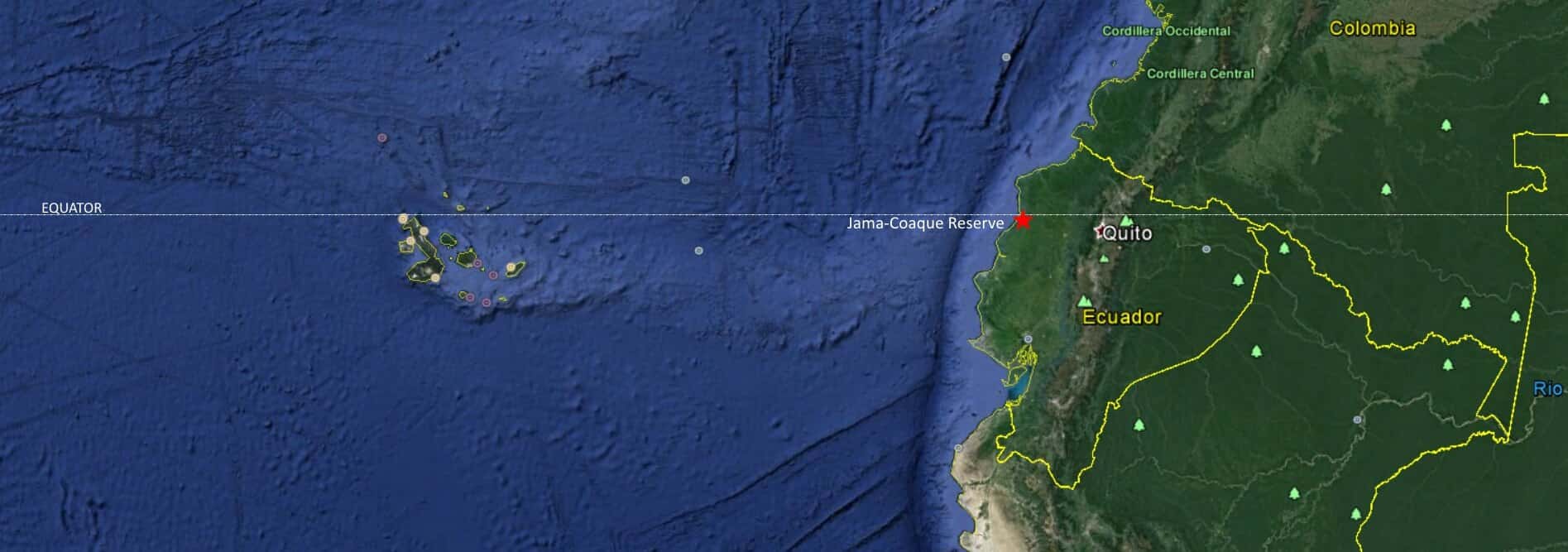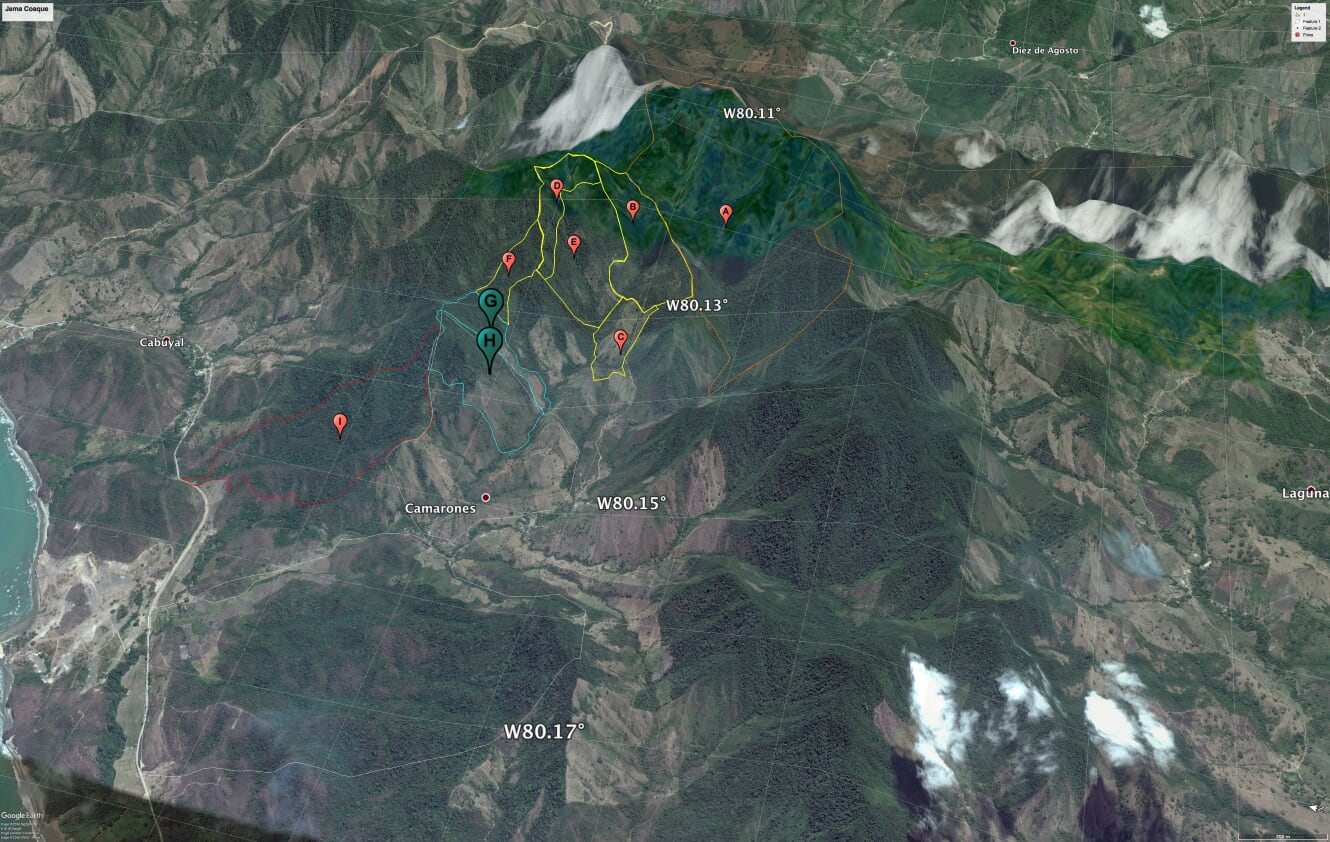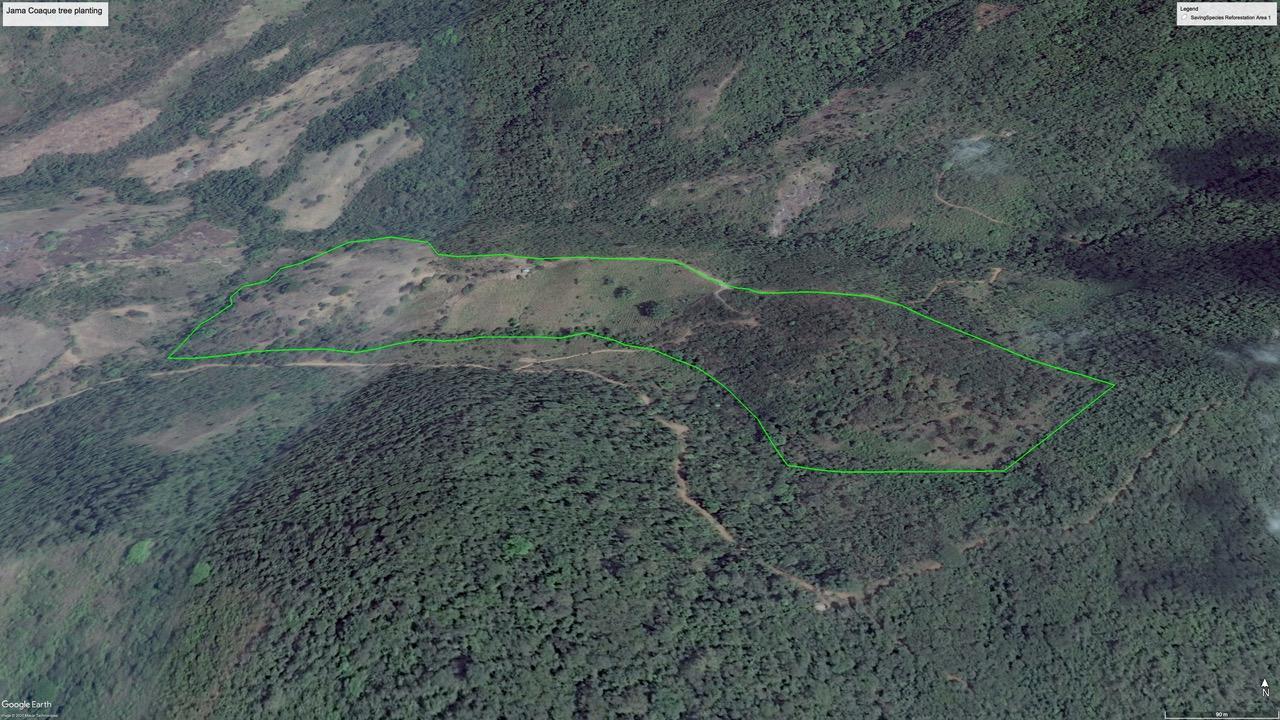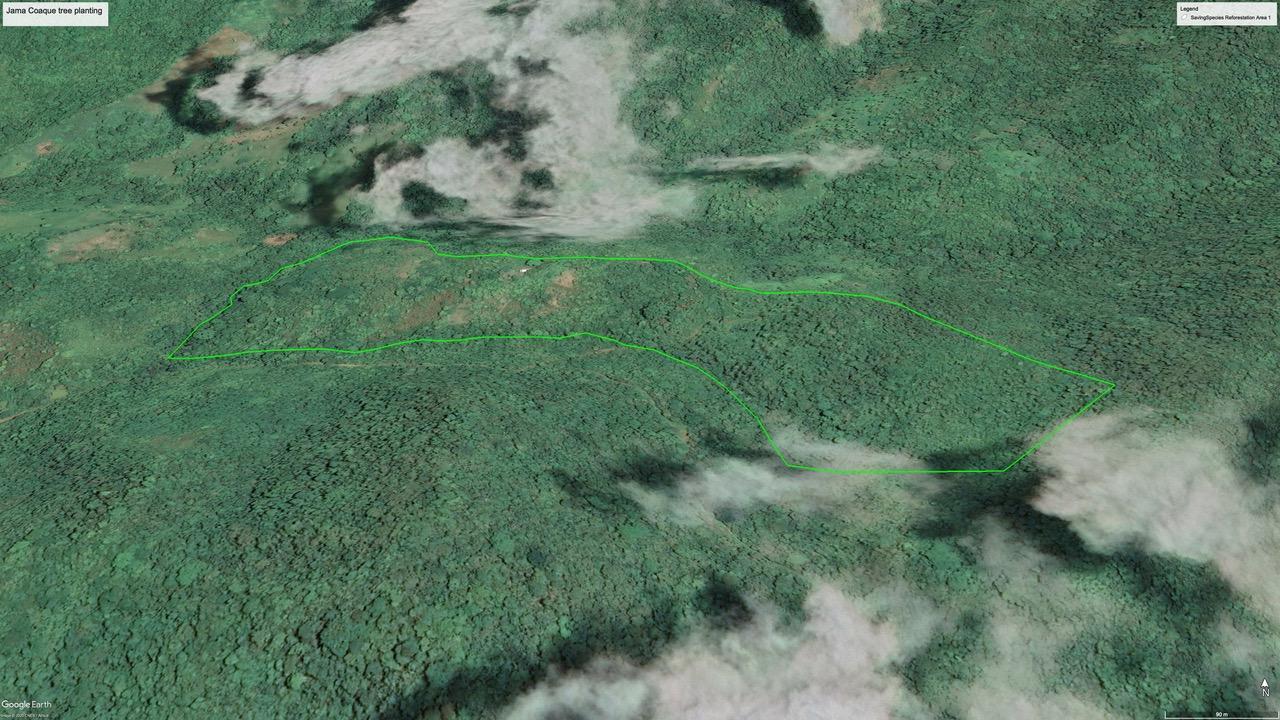Ranked among the 25 most important biodiversity hotspots on the planet, Ecuador’s forests are also among the most severely threatened areas on Earth.
To qualify as a biodiversity hotspot, a region must meet two strict criteria: it must contain at least 1,500 species of vascular plants that exists nowhere else on earth, and it has to have lost at least 70% of its primary vegetation. Around the world, 25 areas qualify under this definition. The Tumbes-Choco-Magedelana is one of them.
Despite being one of the world’s natural treasures, Ecuador is one of the most severely-threatened ecosystems on earth, facing enormous presssue from oil and gas development and logging. In fact, it’s now a global epicenter for biological extinctions and ranks second among Latin American countries for deforestation.
ECUADOR PROJECT
2%
Percent of Forest Remains
2,788+
Endemic Species
2,470
Acres Protected
1,685,304
Trees Planted
10,100
Tons CO2 removed per year
A Race Against Time
Saving Nature is thrilled to support a series of forest corridor restoration projects in the northwest coastal region of Ecuador, helping restore degraded and disappearing forests.
We are working with Fundación Jocotoco, a leading Ecuadorian conservation organization, to purchase strategic parcels of land to impede logging encroachment deep into one of the world’s most spectacular ecosystems. These natural obstacles will also buffer the remote Cotacachi Cayapas Ecological Reserve and its indigenous tribe from intrusion by commercial exploitation.
Ecuador Corridor Goal
Corridor Goal
2,470 acres
Total Cost
$500,000
Funds Raised to Date
$500,000
Support Needed
Corridor Completed!
Protecting Biodiversity Hotspots and Indigenous Culture
Saving Nature has made protecting this important forest and biodiversity hotspot a priority. We are working to safeguard it from exploitation and connect isolated protected areas to form larger expanses of continuous forest. Our goal is to prevent the extinction of rare and endemic species that exist nowhere else on earth. By expanding the effective conservation area and linking existing forest our projects will also increase genetic diversity among populations of endangered frogs, birds, and mammals—including two critically endangered species, the Ecuadorian blue glass frog and the Ecuadorian white-fronted capuchin monkey.
Across its vast expanse, ranging from the Panama Canal to extreme northwestern Peru, the region has an estimated 11,000 vascular plant species, about 25 percent of which are endemic species that exist only here. There are nearly 900 species of birds, including 110 endemics. There are also 300 species of reptiles, among which are 100 endemics, and 200 species of amphibians, 30 of which are endemics. Ecuador has more bird species per acre than any other country. It also has the greatest plant diversity of any South American country and boasts hundreds of frog and reptile species, thousands of kinds of butterflies and countless other invertebrates
Biodiversity in the Jama Coaque Reserve
Biodiversity surveys conducted at the Jama Coaque Reserve in Ecuador’s biodiversity hotspot have cataloged many of the species found here. At last count, there were 270 bird species, 47 reptile species, 18 mammal species, and 28 amphibian species – 3+ species new to science, including the Ecuadorian blue glass frog (Cochranella mache).
Mammals: The Jama Coaque Reserve serves as a refuge for at least one and sometimes two troops of the Critically Endangered Ecuadorian white-fronted capuchin monkey (Cebus albifrons aequatorialis). Each troop of 12 to 20 individuals needs enough forest to forage without competing for resources. The Reserve also supports populations of other primates, like the mantled howler monkey (Alouatta palliata), as well as wild cats like the ocelot (Leopardus pardalis). These species all desperately need their habitat restored and protected to ensure genetic diversity and increase their chances of survival.
Birds: Located within EC010, one of Ecuador’s 107 Important Bird Areas (IBAs), it harbors an incredible diversity of bird species. The Reserve provides refuge for sixteen bird species considered globally threatened or near-threatened. At highest risk are the grey-backed hawk (Leucopternis occidentalis), the slaty becard (Pachyramphus spodiurus), and the grey-cheeked parakeet (Brotogeris pyrrhoptera), all considered Endangered by the IUCN.
For the grey cheeked parakeet, habitat loss and hunting have taken a toll. For some time, the caged-bird trade has highly coveted these sweet, intelligent, playful birds, trapping and removing them in unsustainably high numbers. As a result, an estimated 59,000 grey-cheeked parakeets have passed through international trade checkpoints, destined for pet shops, leaving only about 15,000 in the wild.
Reptiles and Amphibians: In addition, the Reserve hosts a treasure trove of reptiles and amphibians. There are 28 species of frogs (5 globally threatened) and 47 species of turtles, lizards, snakes, andiguanas (18 globally threatened, including the brown wood turtle (Rhinoclemmys annulata). Many of these tiny inhabitants have dwindled in numbers to precarious levels. The IUCN Red List designates seven as Vulnerable, three as Endangered, and one as Critically Endangered – the Ecuadorian glass frog (Cochranella mache).
Endemics: The Jama Coaque Reserve is a conservation priority, due in part to its many threatened endemic species, including 2,750 plants, 22 birds, 7 mammals, and 9 amphibians.
Biodiversity in the Rio Canada Reserve
Also located within the Tumbes-Choco-Magedelana biodiversity hotspot, the Río Canandé Reserve is also a high priority area for conservation of threatened primates, birds, amphibians, and endemic species. It’s a crucial area for the survival of the brown-headed spider monkey (Ateles fusciceps fusciceps), one of the world’s top 25 most endangered primates. Here you will also find the largest population of one of the rarest trees species in Ecuador, as well as 134 of the 212 species of amphibians and reptiles in the Ecuadorian Tumbes-Chocó region.
In addition, the Río Canandé Reserve also provides critical habitat for a number of globally endangered endemic bird species, including the great green macaw (Ara ambiguus), the baudó guan (Penelope ortoni), and the banded ground cuckoo (Neomorphus radiolosus). The Reserve is situated within both the Chocó Endemic Bird Area, which has one of the highest number of range-restricted species (62) in the world and the Verde-Ónzole-Cayapas-Canandé (EC005) Important Bird Area (IBA).
To curb further losses to this biodiversity hotspot and threatened region, the team from Saving Nature joined with IUCN Netherlands to support the efforts of an Ecuador-based non-profit conservation organization, the Third Millennium Alliance (TMA) and its partner Grupo Ecologico Jama Coaque (GEJC). This work is a model of how local conservation efforts, with support from scientists and donors around the world, can make a real difference for the future of nature.
The Jama-Coaque Reserve, named after the Pre-Incan culture that inhabited the area, currently protects 607 hectares of tropical moist forest and pre-montane cloud forest in one of the last major remnants of Pacific Equatorial Forest in the Tumbes-Chocó transition zone along the coastal mountain range of northwest Ecuador. They are hoping to expand the reserve to annex another 546 hectares. The region surrounding the Reserve has seen one of the highest rates of deforestation in South America. Its strategic location along the coastal Manabi mountain range protects the headwaters of two major river systems, which provide water to the community of Camarones and protect the habitats of a variety of rare, endemic, and globally threatened species.
Also extremely important for the protection and conservation of wildlife populations and diversity is the variety of ecosystems in the Reserve. Of the three different ecosystems within the Reserve, the cloud forest is one of the most unique, beautiful, yet threatened ecosystems. The isolation of its forested peaks creates sky islands of biodiversity, with high levels of biodiversity and endemism.
The highest point in the Reserve (Cerro Sagrado peak; 700 m) is almost never without cloud cover; this cloud cover feeds the lower elevation forests within the Reserve as well as household and agricultural activities carried out by the families of Camarones. Many species of birds and amphibians in the Reserve have been documented solely within the cloud forest habitat, where climatic conditions are different from the other two ecosystems. Three potentially new species of frog and salamander have been discovered in the cloud forests surrounding the Cerro Sagrado peak. With further and more rigorous scientific investigation taking place here, more new and rare species will surely turn up within the cloud forests.
We are seeking to create a corridor that will stretch the roughly 3 km forested ridgeline. It will run between the two reserves, thus developing a single continuous protected area approximately 1,000 hectares (almost 2,500 acres) in size. We are executing the project in phases, as strategic parcels become available for sale. As shown in the map, below, we anticipate making a series of discrete land acquisitions to execute our vision.
The map below, created by Dr. Clinton Jenkins, shows the corridor strategy from humid montane forests to dry forest closer to the coast. Each parcel is a critical part of our efforts to protect Ecuador’s stunning biodiversity.
One of the last good tracts of forest in this biodiversity hotspot stretches from the Western highlands down to the Eastern lowlands, of which a large portion is in the Cotacachi Cayapas Ecological Reserve, an area of cultural as well as biodiversity significance. This area is under extreme threat from logging operations that are rapidly clearing these once pristine forests.
We aim to protect an area large enough to maintain populations of species with very large home ranges such as jaguar, harpy eagle, and great green macaw, among dozens of threatened species endemic to the Chocó. A key portion — Río Canandé Reserve — lies within the Tumbes-Chocó-Magdalena biodiversity hotspot and harbors 134 of the 212 species of amphibians and reptiles in the Ecuadorian Chocó region, the Critically Endangered brown-headed spider monkey, and the largest population of one of the rarest endemic tree species in Ecuador.
To save the remaining healthy forest here, Saving Nature has undertaken a bold plan with several important conservation goals. First, we are reconnecting two separated forest fragments to create an approximately 4,500 hectare (ha) protected reserve extremely rich in biodiversity. We are also positioned to impede logging encroachment deep into one of the world’s most spectacular ecosystems. Lastly, we are buffering the remote Cotacachi Cayapas Ecological Reserve and its indigenous tribe from intrusion.
1. Building A Wildlife Corridor: The project’s 68-hectare (168-acre) restoration area is located in coastal north-western Ecuador and will help protect many species. It stitches together a single, continuous, jointly-protected area of nearly 4,500 hectares, simply by acquiring a strategic parcel of land that stands directly between two protected areas. Once purchased, this parcel will connect Canandé Reserve (2,500 ha) to the Tesoro Escondido Reserve (1,900 ha). Notably, the leverage in terms of conservation merits of this relatively small purchase is extremely high. It will create both a strong defense against deforestation in western Ecuador and bulwark for biodiversity.
2. Hindering Logging Operations: We are also helping our partner acquire land to the east of this soon-to-be 4,500-ha protected area. Our vision and plan is to purchase land in sites that are likely to lead to further development (e.g., timber road construction, etc) and eventual logging deeper in the remaining untouched forests of this biodiversity hotspot. Using state-of-the-art technology, like satellite imagery and drones, Saving Nature and Fundación Jocotoco are identifying and purchasing strategic tracts of land that will hinder further development and make logging less economically-viable. That will give both the forests and their threatened wildlife a chance to thrive. It is a race against time, and logging interests in this part of the world are powerful and often ruthless. But we at Saving Nature are proud to be in the vanguard of effective and strategic conservation in this part of the world.
3. Buffering Indigenous People from Intrusion: The stakes are high for, both, biodiversity hotspots and indigenous people. Bulldozers and chainsaws are moving east in the direction of the remote Cotacachi Cayapas Ecological Reserve and its indigenous tribe. This 750,000 acre reserve is a protected sanctuary for their ancestral lands and for jaguars, tapirs, and spectacled bears to live in a relatively untouched wilderness. Logging roads and deforestation threaten their solitude.
We have partnered with Fundación Jocotoco, an Ecuador-based nonprofit conservation organization, who will manage and defend the new protected areas. They are a credible and effective local NGO working to protect the rich biodiversity of Ecuador. They currently own and manage Canande Reserve, a beautiful 2,500 hectare (ha) protected area of significant biodiversity and importance for threatened species. Our partnership focuses on two main conservation goals: 1) to connect two large, isolated forest protected areas, and 2) to substantially slow down deforestation through strategic land purchases in currently unprotected forests a little to the east of those two protected areas.
Since launching in 2014, our corridor projects in Ecuador have achieved several milestones in connecting isolated forests:
- Purchased 760 hectares in the Tumbes-Chocó region.
- Added 98 hectares of corridor to the Jama Coaque Reserve to create a vital habitat connection.
- Expanded the land under protection in the Rio Canade Reserve by 662 hectares through a series of land strategic land acquisitions. The resulting corridors not only closes the gap between isolated forests, but blocks logging roads from penetrating deeper into remote areas of the forest and toward the indigenous reserve. Restoration work in ongoing in all three corridors, which are not at various stages of regeneration.
- In 2018, we began the work of monitoring species recovery with camera traps recording both photos and videos. We have recorded over 200 images and 70 videos, documenting 19 species moving through the corridor, including ocelots, coatis, crab eating raccons, agoutis, and reptiles.
Regeneration of habitat is an important measure of project success. We monitor habitat restoration progress with an annual drone survey to evaluate progress in establishing a continuous canopy. This data is the foundation for modelling forest regeneration in tropical landscapes to determine the pace of forest recovery.
Jama Coaque Corridor
Our Jama Coaque project has seen tremendous regrowth of trees in their portion of Ecuador’s Tumbes-Choco biodiversity hotspot. As shown in the before and after photos below, the transformation from cattle pasture to forest is well on its way to completion.
Jama Coaque Corridor 2013:
Jama Coaque Corridor: 2018
Photo Credits:
- Harpy Eagle by Xavier Munoz
- Great Green Macaw by Xavier Munoz
Copyright 2025 Saving Nature | fGreen Theme powered by WordPress




